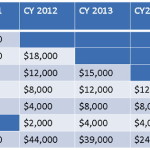Last week, on Friday the 13th no less, CMS posted the latest figures related to the EHR Incentive Program. On a monthly basis CMS posts a report detailing registration and attestation numbers for hospitals and eligible professionals categorized by Medicare and Medicaid. Friday’s report is of interest as it effectively recaps the first year of the meaningful use program. Let’s take a closer look at some of the numbers with a special focus on nephrology.
As of the end of 2011, CMS had distributed just over $2.5 billion in incentives to hospitals and eligible professionals who were able to attest to the fact that they had demonstrated the meaningful use of certified EHR technology during 2011. Let me repeat, over the course of 12 months, $2,500,000,000 changed hands as part of this incentive program. That is a very large sum of money regardless of your perspective.
Almost 80% of the incentives paid to date have gone to hospitals, with the balance, roughly $570 million, paid to eligible professionals. We can drill down on this later group a bit more by splitting the eligible professionals into Medicare and Medicaid buckets. These two groups include about 30,000 individuals in total who are almost equally split between the two programs. The Medicare bucket, which in our experience includes the vast majority of successful nephrologists, includes just over 15,000 eligible professionals. Within this group are almost 400 nephrologists.
Technically this is not the end of the story for 2011 as the reporting window remains open through the end of February. In fact, the folks that attested in December are not counted in this tally. CMS is reporting those who have been paid through the end of the year. It will take a couple of months for the dust to settle before we know how many providers were actually successful at reporting year 1 in 2011, but these numbers do provide us with insight.
First, demonstrating meaningful use remains popular among nephrologists relative to other specialties. Nephrology remains on the “top 10” list of eligible professionals demonstrating MU via the Medicare path as depicted in this table from the CMS web site:
Figure 1: Eligible professionals demonstrating meaningful use in 2011 (Medicare).
Given the relative size of our specialty, this ranking is nothing short of remarkable. Second, take a look at the growth in participation by month. Some might argue I have too much free time on my hands, but if you take the numbers from the CMS web site over the past few months, the cumulative figures for nephrologists demonstrate steady growth in participation through the end of 2011. In fact over the last two months of 2011, more than 100 nephrologists per month received the $18,000 year 1 incentive.
Figure 2: Nephrologists receiving the Medicare MU payment (cumulative).
So has the program been successful? That’s a tough question to answer and one that will take years to clarify. At this stage of the game, perhaps the best measure of success is participation. There are of course no historic benchmarks upon which to base performance. However, there were some well reasoned predictions made by Health and Human Services, recorded for posterity in the final rule published in the Federal Register during July of 2010. HHS was compelled to make forecasts regarding participation as part of the required budgeting process. Prudently they established both a “low” and a “high” scenario and calculated costs based on both estimates.
While the data in Figure 1 does not represent the official 2011 total, one can clearly see the program has missed even the low target (40,000 Medicare eligible professionals) by almost 50%. The high scenario estimated 137,000 Medicare eligible professionals would attest in 2011 (which makes one wonder what definition of the word “high” they were using that summer). Interestingly, the dollar figure fell between the low ($1 billion) and the high ($2.8 billion) scenarios, in large part due to an over-estimate of eligible professional participation and an under-estimate of hospital participation. Perhaps hospitals were better prepared than physicians and other eligible professionals?
What does this mean for nephrology? I suspect not much. However, I would not discount the feedback this provides to CMS. I think there were several reasons ONC proposed delaying the Stage 2 objectives, and one of those reasons was to spur participation. I also believe ONC is “listening” to the provider community and searching for additional ways rev up interest. What are your thoughts regarding year 1 and what are your plans for 2012? Post them here to join the conversation.






Leave a Reply